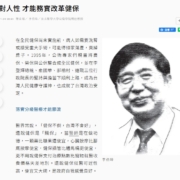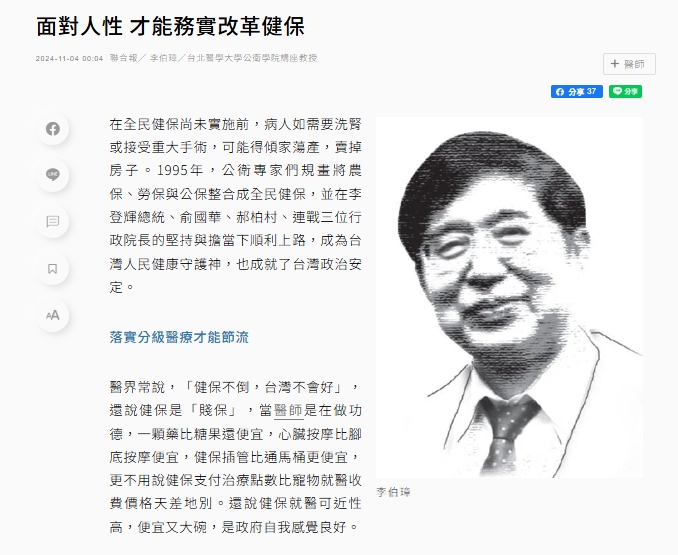【Column Article】Daily News – “Director Lee Po-Chang: Facing Humanity for Pragmatic Healthcare Reform”
By Lee Po-Chang / Chair Professor at the College of Public Health, Taipei Medical University
Published Date: 2024-11-04
Before the implementation of National Health Insurance (NHI), patients requiring dialysis or major surgeries might have had to sell their homes, potentially going bankrupt. In 1995, public health experts planned to integrate agricultural insurance, labor insurance, and public insurance into a unified National Health Insurance system. With the insistence and commitment of President Lee Teng-hui and three successive Premiers—Yu Kuo-hwa, Hau Pei-tsun, and Lien Chan—the NHI was successfully launched, becoming the guardian of Taiwanese people’s health and contributing to Taiwan’s political stability.
Implementing Hierarchical Medical Care to Save Costs
In the medical community, there’s a saying: “If NHI doesn’t fail, Taiwan won’t improve,” implying that NHI is undervalued. Doctors claim they’re performing charitable work, with medicines cheaper than candy, cardiac massage cheaper than foot massage, and intubation under NHI cheaper than unclogging a toilet. Moreover, the cost difference between NHI and veterinary care is stark. NHI’s accessibility, affordability, and “more for less” approach are often viewed by the government with pride.
With President Lai being from the medical field, he has actively promoted “Healthy Taiwan,” a goal that requires everyone’s concerted effort.
The NHI’s financial model is to spend only what it has, unlike commercial insurance, which is profit-driven. Therefore, the implementation of hierarchical medical care with a “user-pays copayment” policy is crucial as a first step in cost-saving.
Patients and pharmaceutical companies often request new drugs and specialty materials to be covered by NHI. Similarly, the medical community demands the inclusion of new medical technologies. These additions inevitably raise the NHI point quota. However, NHI’s budget cannot keep up with the growth of point values, causing the “floating point value” of medical services to decrease. If the government only aims to increase the overall budget by supplementing from other public funds, it would be like pouring a cup of water onto a burning car. This approach not only distorts the budget system’s financial discipline but also risks creating a nightmare for NHI.
Medical staff in regional hospitals and local clinics possess high-level medical skills and abilities. The government has a responsibility to promote hierarchical medical care, ensuring that every primary care physician can act as a family doctor, allowing specialized hospital doctors to focus on critical cases.
Chronic Diseases and the Challenge of Unhealthy Life Expectancy
Chronic diseases are most closely associated with unhealthy life expectancy. In 2023, the NHI recorded 209 million outpatient claims for “non-chronic disease patients” and 91.38 million for “chronic disease patients,” a difference of 2.29 times. For primary care in Western medicine, “non-chronic disease patients” accounted for 156 million claims, while “chronic disease patients” accounted for 37 million, a difference of 4.25 times. In hospitals, “non-chronic disease patients” accounted for 55 million claims and “chronic disease patients” for 53 million, reflecting a similar ratio.
Analysis shows that non-chronic patients outnumber chronic patients at every level. Managing chronic diseases requires health education and support for lifestyle changes. Without adequate time to care for chronic patients, unhealthy life expectancy will not improve, making pragmatic reform essential.
Fair Reimbursement Points for Inpatient Care
NHI expenditure allocation shows outpatient services at 70.3% and inpatient services at 29.7%. Drug costs constitute 32.58% of the total, and the defensive medical ecosystem continues to drive up testing and examination costs. Long-standing suppression of reimbursement points for surgeries and certain invasive treatments has yet to be practically adjusted, leading to urgent issues such as “sweatshop hospitals,” nurse turnover, and bed closures.
Ensuring fair reimbursement points for life-saving “inpatient medical services” will be the most pragmatic focal point in various NHI reform projects. Healthcare professionals and empowered officials must take responsibility and engage in thorough communication with payor representatives to implement realistic NHI reforms, so that the public can continue to enjoy the well-being and happiness brought by the NHI system.
Source: United Daily News – “Director Lee Po-Chang: Facing Humanity for Pragmatic Healthcare Reform”




